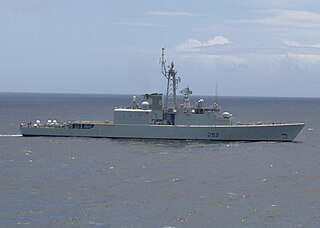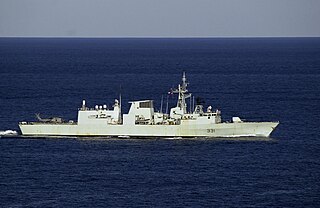
The Royal Canadian Navy is the naval force of Canada. The RCN is one of three environmental commands within the Canadian Armed Forces. As of 2021, the RCN operates 12 frigates, four attack submarines, 12 coastal defence vessels, eight patrol class training vessels, two offshore patrol vessels, and several auxiliary vessels. The RCN consists of 8,570 Regular Force and 4,111 Primary Reserve sailors, supported by 3,800 civilians. Vice-Admiral Angus Topshee is the current commander of the Royal Canadian Navy and chief of the Naval Staff.
The history of the Royal Canadian Navy goes back to 1910, when the naval force was created as the Naval Service of Canada and renamed a year later by King George V. The Royal Canadian Navy (RCN) is one of the three environmental commands of the Canadian Forces. Over the course of its history, the RCN has played a role in the First World War, contributed significantly to the Battle of the Atlantic during the Second World War, and was a part of NATO's force buildup during the Cold War. In 1968, the RCN was amalgamated with the Canadian Army and the Royal Canadian Air Force to form what is today the unified Canadian Armed Forces. The naval force was known as Maritime Command until 2011, when the environmental command was renamed as the Royal Canadian Navy.

Iroquois-class destroyers, also known as Tribal class or DDG 280 class, were a class of four helicopter-carrying, guided missile destroyers of the Royal Canadian Navy. The ships were named to honour the First Nations of Canada.

HMCS Toronto is a Halifax-class frigate that has served in the Canadian Forces since 1993. Toronto is the fourth ship in her class which is the name for the Canadian Patrol Frigate Project. She is the second RCN ship to be named for Canada's largest city. When not on operations she is assigned to Maritime Forces Atlantic (MARLANT) and is based at CFB Halifax. Toronto serves on MARLANT missions protecting Canada's sovereignty in the Atlantic Ocean and enforcing Canadian laws in its territorial sea and exclusive economic zone.

HMCS Athabaskan was an Iroquois-class destroyer that served in the Royal Canadian Navy from 1972 until 2017. Athabaskan was the third ship of her class which is sometimes referred to as the Tribal class or simply as the 280 class. She is the third vessel to use the designation HMCS Athabaskan.

HMCS Vancouver is a Halifax-class frigate, of the Royal Canadian Navy launched on 8 July 1989, as the second vessel of her class. She is based at CFB Esquimalt on the west coast of Canada, and is the third vessel to be named after Vancouver, British Columbia.

HMCS Calgary is a Halifax-class frigate that has served in the Canadian Forces and Royal Canadian Navy since 1995. Calgary is the sixth vessel in her class and the second vessel to carry the designation HMCS Calgary. She was built as part of the Canadian Patrol Frigate Project. Calgary began the FELEX refit in June 2012. She is assigned to Maritime Forces Pacific (MARPAC) and is homeported at CFB Esquimalt. Calgary serves on MARPAC missions protecting Canada's sovereignty in the Pacific Ocean and enforcing Canadian laws in its territorial sea and exclusive economic zone.

HMCS Charlottetown is a Halifax-class frigate that has served in the Royal Canadian Navy since 1995. Charlottetown is the tenth ship in her class which is based on the Canadian Patrol Frigate Project. She is the third vessel to carry the designation HMCS Charlottetown. Charlottetown, assigned to Maritime Forces Atlantic (MARLANT) and homeported at CFB Halifax, serves on missions protecting Canada's sovereignty in the Atlantic Ocean and enforcing Canadian laws in its territorial sea and exclusive economic zone. Charlottetown has also participated in several NATO missions, patrolling the Atlantic Ocean as part of Standing Naval Force Atlantic (STANAVFORLANT) and its successors Standing NATO Maritime Group 1 and 2. Charlottetown has also been deployed on missions throughout the Atlantic and to the Indian Ocean, specifically the Persian Gulf and Arabian Sea on anti-terrorism operations.

HMCS Ottawa is a Royal Canadian Navy Halifax-class frigate. Ottawa is the twelfth and final ship of the Halifax class that were built as part of the Canadian Patrol Frigate Project. She is the fourth vessel to carry the name HMCS Ottawa. The first three were named for the Ottawa River. This ship is the first named for Canada's national capital, the City of Ottawa. She is assigned to Maritime Forces Pacific (MARPAC) and is homeported at HMC Dockyard, CFB Esquimalt. Ottawa serves on MARPAC missions protecting Canada's sovereignty in the Pacific Ocean and enforcing Canadian laws in its territorial sea and Exclusive Economic Zone. Ottawa has also been deployed on missions throughout the Pacific and to the Indian Ocean; specifically the Persian Gulf and Arabian Sea on anti-terrorism operations.

HMCS Regina is a Halifax-class frigate that has served in the Canadian Forces and Royal Canadian Navy since 1993. Regina is the fifth vessel in her class which is the name for the Canadian Patrol Frigate Project. She is the second vessel to carry the designation HMCS Regina. She is assigned to Maritime Forces Pacific (MARPAC) and is homeported at CFB Esquimalt.

HMCS Winnipeg is a Halifax-class frigate that has served in the Royal Canadian Navy since 1996. Winnipeg is the ninth ship in her class, whose design emerged from the Canadian Patrol Frigate Project. She is the second Canadian warship to carry the name HMCS Winnipeg. Winnipeg serves on Canadian Forces MARPAC missions protecting Canada's sovereignty in the Pacific Ocean and the Arctic Ocean and in enforcing Canadian laws on its territorial oceans and Exclusive Economic Zone. The vessel has been deployed on missions throughout the Pacific, and also to the Indian Ocean; specifically on anti-terrorism operations in the Persian Gulf and the Arabian Sea, and counter-piracy operations off the coast of Somalia. The ship is assigned to the Maritime Forces Pacific (MARPAC), and she has her home port at the Canadian Forces Maritime Base at Esquimalt.

HMCS Algonquin was an Iroquois-class destroyer that served in the Royal Canadian Navy (RCN) from 1973 to 2015.

HMCS Huron was an Iroquois-class destroyer that served with the Canadian Forces from 16 December 1972 to 23 October 2000. It served mainly on the western coast of Canada. After decommissioning, its hull was stripped to be used in a live-fire exercise. The ship's hulk was eventually sunk by gunfire from its twin ship, HMCS Algonquin. Huron was the second ship of its class and the second vessel to use the designation HMCS Huron.

HMCS Iroquois was the lead ship of the Iroquois-class destroyers of the Royal Canadian Navy, also known as the Tribal class or the 280 class. The second vessel to carry the name, she carried the hull number DDG 280. Entering service in 1972 she was assigned to Maritime Forces Atlantic (MARLANT) and was homeported at CFB Halifax. Iroquois was deployed overseas for blockade and anti-terrorism duties, including participating in Operation Apollo in 2002–03. Taken out of service in 2014 and paid off in 2015, the ship is currently awaiting disposal.

HMCS Brandon is a Kingston-class coastal defence vessel that has served in the Canadian Forces since 1999. Brandon is the eleventh ship of her class. She is the second vessel to use the name HMCS Brandon. The Brandon is assigned to Maritime Forces Pacific (MARPAC) and is homeported at CFB Esquimalt.

HMCS Yellowknife is a Kingston-class coastal defence vessel that has served in the Canadian Forces since 1998. Yellowknife is the seventh ship of her class. She is the first vessel to use the designation Yellowknife in the Royal Canadian Navy. The coastal defence vessel is assigned to Maritime Forces Pacific (MARPAC) and is homeported at CFB Esquimalt.

Her Majesty's Canadian Ship (HMCS) Protecteur was the lead ship of the Protecteur-class replenishment oilers in service with the Royal Canadian Navy. She was part of Maritime Forces Pacific (MARPAC), homeported at CFB Esquimalt, British Columbia. Built by Saint John Shipbuilding and Dry Docks in Saint John, New Brunswick, she was commissioned on 30 August 1969. She was the first Canadian naval unit to carry the name Protecteur; however, there have been several units, including a base, named HMCS Protector.
Operation Caribbe is the Canadian Armed Forces contribution to the elimination of illegal trafficking in the Caribbean Sea and the eastern Pacific Ocean by organized crime. The operation began in 2006 and its mandate has been altered twice since then.

MV Asterix is a Canadian commercial container ship. It was purchased by Federal Fleet Services as part of Project Resolve, and was later converted into a supply ship for the Royal Canadian Navy (RCN). She is intended to act as an interim replacement between the out of service Protecteur-class replenishment oiler and the future Protecteur-class auxiliary vessel. Originally launched in Germany in 2010 as Cynthia, the ship was converted and delivered to the RCN in December 2017 when she will be leased to the navy with a merchant navy crew, complemented by RCN personnel. Asterix will be in Canadian service well into the 2020s.
The following is a hierarchical outline for the Canadian Armed Forces at the end of the Cold War. It is intended to convey the connections and relationships between units and formations.
















